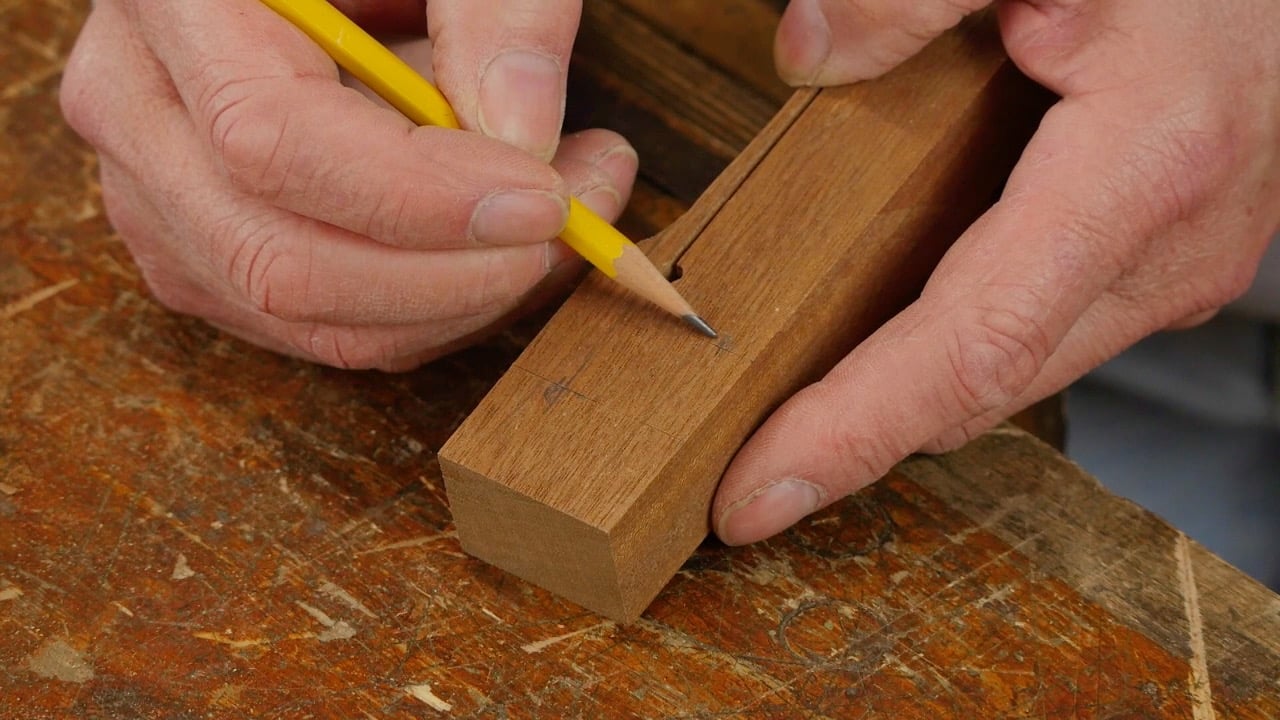Cam Clamp – Episode 2
Posted 4 March 2016
This is an episode in a free series. Want to watch it? It is free to do so, you just need to log into the site, and you can enjoy this video and many other videos we think you will love.
Paul cuts the mortise in the moving part to receive the bar, after drilling the holes to receive the roll pins. Once the mortise is cut, the roll pins are inserted and cut flush with the surface. They help to reinforce the pivotal pressure points.


Wonderful. Thanks!
We won´t be disappointed if part 3 shows up real soon. 🙂
Thanks guys!
As always a great and simple way to do it!
Do you think the mortising would work with 1/8″ bevel edged chisel? That’s the only 1/8 I have but it seems like it would be too fragile.
Paul has used standard bench chisels in other lessons, and they worked just fine. Take smaller bites and you’ll probably be OK.
Pleasure watching it come together Paul, thanks.
How about leaving up a picture of your ‘plan’ (sketch) to get the measurements?
Hi Dave,
project page now posted here: https://woodworkingmasterclasses.com/2016/03/cam-clamp-project-info/
Happy woodworking, Resi
Paul it is nice to see someone so dedicated and professional in there craft. Love your work Paul’
Always a pleasure watching your craftsmanship! You mentioned in Episode 2 that the mortising chisel does not have a bevel as you put on bench chisels. You have probably in some class that I missed said why that is; so I ask why no bevel on a mortising chisel?
Forrest,
Paul’s comment was about the length of the bevel on the mortise chisel he’s using being longer than that on a bevel edge bench chisel and thus applies more pressure when levering. They both have a bevel but the mortise chisel is wider.
Hope this helps.
Best,
Craig
Mainly because thin chisels like this don’t really need a bevel as they are so narrow. I have both, but because they are so thin they can snap so any metal that can be retained is better.
I’m having a reality problem, feeling a bit light-headed–I thought I saw Paul using a power tool for making a mortise 🙂
Wonderful series. I built a pair of these (9-inch throat) myself a while back after seeing a luthier demonstrate them. I seldom use them, but when you need them, nothing else will do.
Yes, but it was a hand held power tool….. 😉
Thank you for the lesson.
Paul, thanks for the videos. I always enjoy watching and learning from you.
I am unfamiliar with the wood you said you were using on these clamps. Sapita? I tried googling it, and got nowhere, so probably my spelling is wrong.
It’s called Sapele, Mary Kathryn.
love your easy still of woodworking keep going .
THANKS Gary
Thank you, This is another good lesson in tool making.
Beautiful! Thank you Paul.
I tried to find the kind of pin you describe that “rolls ínto itself” but I seem fail.
If I understand you correctly this is of thinner material than a slotted pin and similar to a “rolled wafer”.
Please tell me wher to find such rolled pins.
All I can find on ebay are of slotted type.
Are the coil pins US and the slotted European perhaps?
All of the roll pins I’ve seen in the US are the slotted ones. I’ve never seen one that coils in.
One explanation I’ve seen is that the rolled pins are a bit more automation friendly in that they there are no slots that can accidentally interlock and jam the insertion machinery.
You described it well as a wafer rolling into itself from thin plate stock. That’s exactly what it does. Both pin types work well. I am sure that both types will be available but I do not know where to send you in the USA except to try MSC Industrial Supply and look through their million of pages.
In the US you can get them from Fastenal:
https://www.fastenal.com/products/fasteners/pins/spring-pins;jsessionid=4B3A6D2A581CD273FDF68EC46B25752C.fcomjvm03?r=~|categoryl1:%22600000%20Fasteners%22|~%20~|categoryl2:%22600108%20Pins%22|~%20~|categoryl3:%22600120%20Spring%20Pins%22|~%20~|sattr04:^%22Coiled%20Spring%20Pin%22$|~
“roll” pins are described as “spring” (or “slotted”) pins or “coiled” pins.
Forrest
Lowes has them in the specialty fasteners bins. Slotted pins is how they title it.
very good informative step by step instructions. With regard to the jig for drilling square I find if you cut a v shape in the jig it gives a precise location for your designated hole.
How would you make the mortise if you don’t have that narrow of a chisel? Just drill it out and pare down the walls?
Or use thicker bar stock instead. I could use a couple of these myself and the narrowest chisel I have is 1/4″. I’ll be getting 1/4″ bar stock, not 1/8″. Simple solution. If you’re worried about weight get aluminum instead of steel.
The “coiled” pins Paul references are made by Spirol International in Danielson, Connecticut, USA. They have 2-1/4 turns. Google “Spirol Pins” and I’m sure you will find local source(s) that carries them. After you start looking for them you will see how widely they are used in both static and dynamic applications. Particularly in hinge applications. They are widely used by the automotive and appliance industry. I hope this helps.
Really enjoyed the video. Is they’re anychance you can put a link to where you got the pins I am in the uk and have searched eBay but only found the slotted ones.
Thanks again
Just on the subject of the pins, I couldn’t get them and I used nails–and the clamps are 100% fine.
I made some bigger ones, too, and just used… bigger nails.